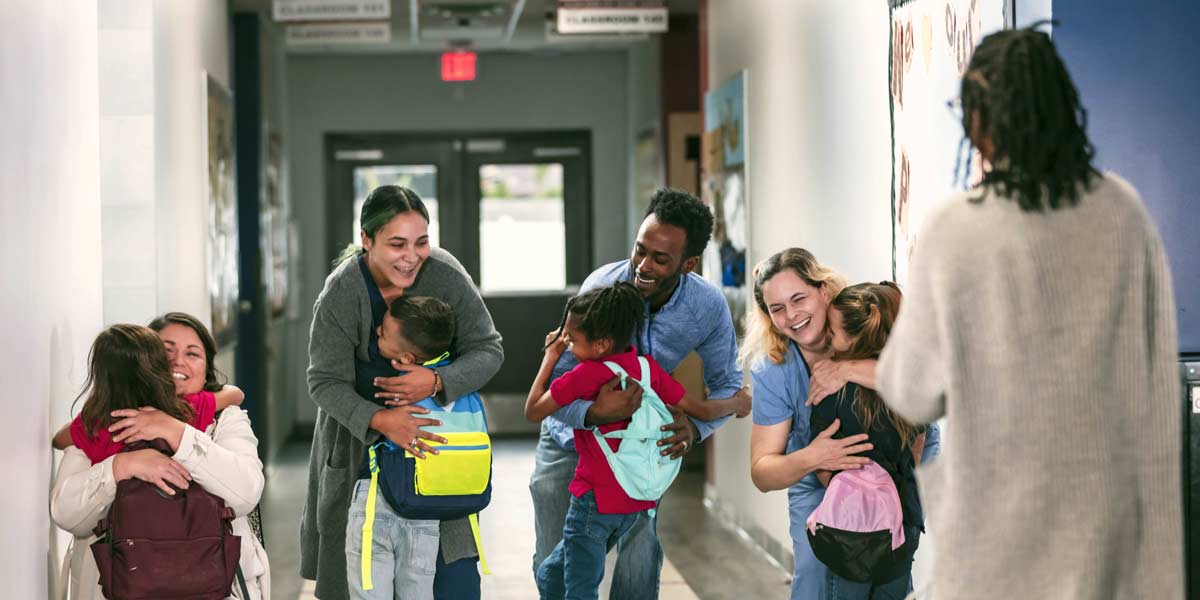Leading Together: A New District Tool for Family Engagement

When I was a new school leader, I often felt uncertain about how to engage families. I struggled to work with parents labeled as “difficult” and got nervous to meet with families who were upset or disagreed with the school’s approach.
One year, a student was experiencing mental health issues that impacted other students and made it challenging for them to fully engage in their education. The child’s family and I started to spend a lot of time together—not super willingly at first. Over time, I realized how stressful the situation was for everyone. We all had to work together to help this student; none of us could do it alone.
I began to take a different stance. I no longer shied away from challenges or differences of opinion. Instead, I embraced listening and collaboration. I recognized the parents as experts on their child and asked them, “What have you tried that has helped? What do you know about your child that might help us be more effective? What could we try together?”
On reflection, I struggled because, as a new leader, I was navigating this work on my own. The system had not prepared me for authentic family engagement: I didn’t know how to share power with families or make them feel heard. The lack of training and support made me feel hesitant, nervous, and alone—and left our families and students without support, too.
Toward Districtwide Family Engagement Systems
Today I help other education leaders avoid the pitfalls of siloed family engagement through my work at the Washington Statewide Family Engagement Center. At WASFEC, we know that authentic partnership with families is key to student success. Extensive research proves that families play an important role in positive educational outcomes: Families not only support their own children but also can promote systemic change by becoming advocates and leaders in schools. Building asset-based relationships with families strengthens our systems and supports us to educate students in a holistic way, one that welcomes the rich diversity of experience and knowledge that families bring.
The WASFEC team also knows that family engagement is dynamic work that requires systems-level solutions. District leaders play an important role in preparing educators at every level, from staff members to school leaders, to engage families authentically. District leaders create the vision, elevate family engagement as a priority, and invite families, community, and other partners into the work. Leaders can also see potential levers for integrating family engagement practices across the system and use them to spur the community to action.
District leaders play an important role in preparing educators at every level, from staff members to school leaders, to engage families authentically.
A New Self-Assessment Tool for Districts
For many years, school districts across Washington state have identified family engagement as a priority. But many leaders still aren’t sure about where to start or how to implement evidence-based strategies in a systemic way that goes beyond compliance. (From experience, I know this is often the hardest part: If it were easy, we would all be doing it!)
Recognizing this challenge, our team at WASFEC developed a new tool: the District Self-Assessment for Systemic Family Engagement Practices. Teams can use this tool to assess family engagement at a systems level, using a collaborative process that engages families and is rooted in the Washington context. Our design provides flexibility for leaders or teams to move at their own pace as they engage in the assessment and to invest the time needed to shape district priorities around family engagement. A parallel tool that focuses on school-level practices is also available: School-Based Self-Assessment for Systemic Family Engagement Practices.
A Systems-Level Approach
This tool supports district teams to take a big picture view of family engagement—to understand current practices, strengths, and areas for growth at the district level. It highlights evidence-based best practices and effective strategies while allowing teams to reflect on application in their unique context. For example, teams will be able to assess their district vision, values, and goals for family engagement to ensure that family voice and partnership is reflected across their system. This tool creates an opportunity to discuss where your district is right now and plan to move things forward with an embedded systemic approach.
Designed for Collaboration
We designed this tool to be used by a collaborative team of district leaders and family and community partners, such as community-based organizations that work with local youth or families. Multiple perspectives and viewpoints will generate a more complete understanding of system practices for family engagement. Taking a collaborative approach to this tool also sets the tone for authentic engagement in the future.
Although the tool can be used by an individual, we recommend it be used by a collaborative team that represents the diverse roles within the district community.
Rooted in Washington
We designed the self-assessment with a focus on Washington school districts. From our experience, we know that context is critical in education. This tool reflects a deep understanding of Washington, and the resources Washington educators rely on to make systems change. We collaborated with WASFEC partners Right Standing Solutions, Roots of Inclusion, the Washington State Office of Superintendent of Public Instruction, and members of our family advisory board to align the self-assessment with the dual capacity framework, Washington Family Engagement Framework, and SISEP District Capacity Assessment used by OSPI.
Call to Action: Now Is the Time to Lead for Family Engagement
Families are our closest allies in our students’ success. During times of great change and uncertainty, engaging families as partners is even more critical.
Families are our closest allies in our students’ success.
To succeed in this work, we must equip all educators and school leaders with the right knowledge, resources, and supports to partner with families. That starts with district leaders setting the vision, engaging the right network of partners, and building strong family engagement systems.
Our self-assessment is the first step in this journey. Access these additional resources to continue on the path toward systemic family engagement:
- Participate in the WASFEC District Community of Practice to deepen your family engagement work alongside other education leaders in Washington
- Explore WASFEC’s library of family engagement resources
- Contact a WASFEC team member for personalized support
Jennifer Johnson has worked in public education for over 25 years, with a focus on supporting diverse multilingual populations in underserved schools. Prior to joining Education Northwest, she was a dual language teacher, bilingual instructional coach, building principal, district-level multilingual director, state dual language task force member, and WIDA professional development trainer.



